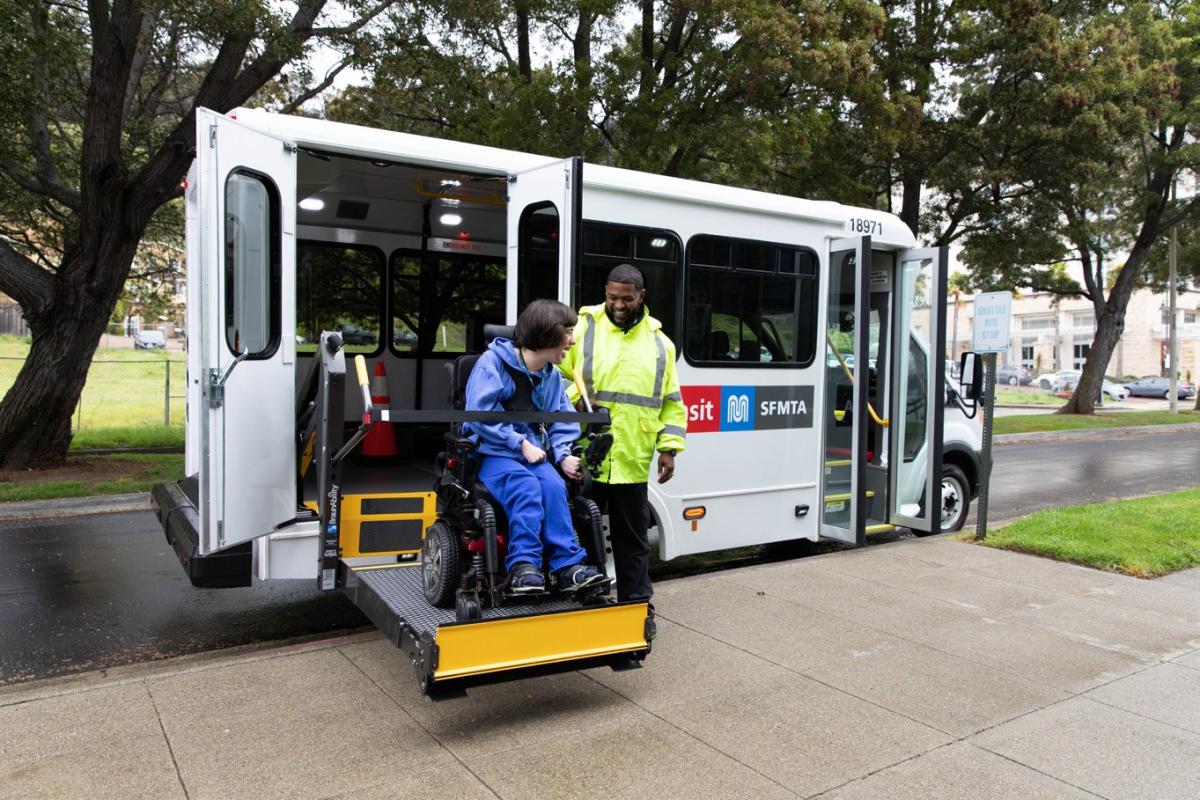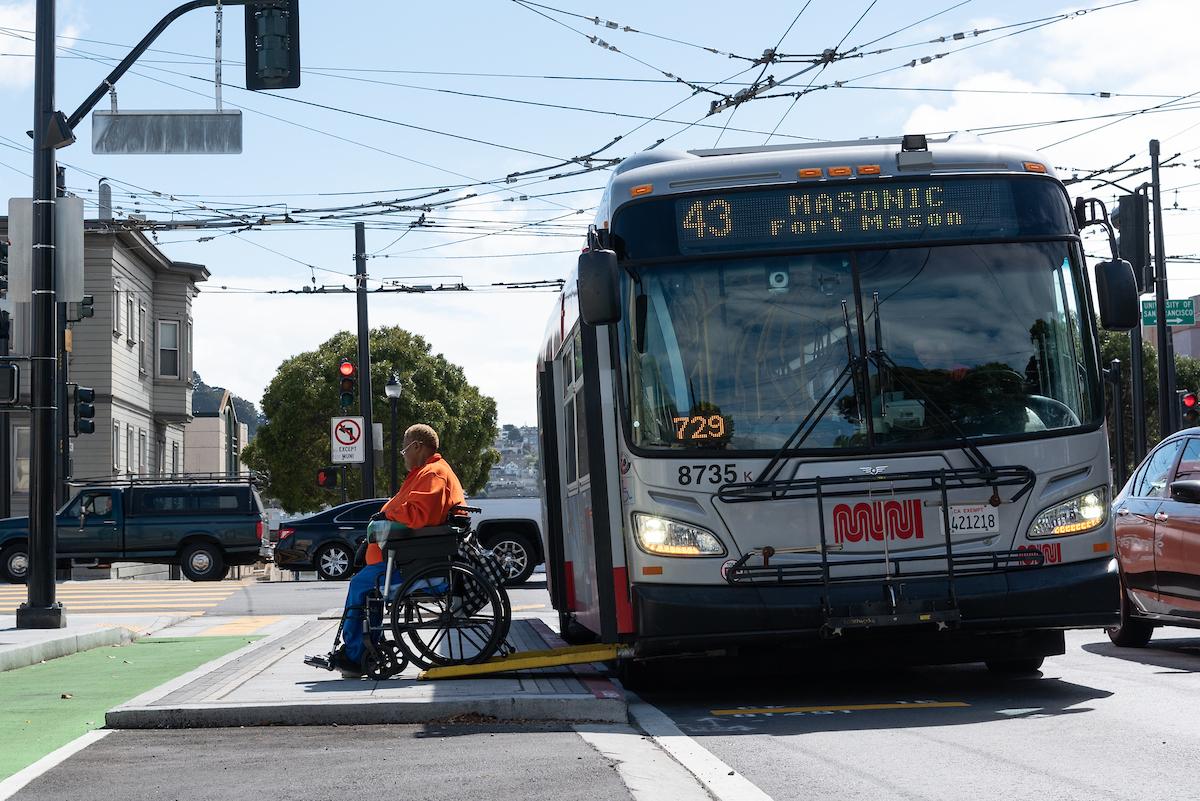
Seniors and people with disabilities have a range of ways to go green with us.
During Climate Week and all year long, our teams work together to ensure everyone can take green trips around the city. We’re proud to share the investments we’re making across our system to improve access for seniors and people with disabilities.
This means providing reliable trips for people who choose shared-ride paratransit or our clean-air taxis. It means making it easier to board electric Muni vehicles. It means ensuring adaptive scooters are part of the scooter share fleet, and that we support adaptive cycling events.
“Seniors and people with disabilities are using our services for everything, really,” SFMTA Acting Director of Accessible Services Erin McAuliff said. “We have folks going to work on a daily basis, seeing friends and family, catching a game or a show. We also have people using Muni, paratransit shuttles and taxis for medical needs. They rely on us to get to recurring appointments, like dialysis or chemotherapy.”
“Our work in accessibility is breaking down barriers,” McAuliff said, “so that people can live their lives with the certainty that they can get where they need to go.”
As an agency, we’re thrilled to see:
- 98.7% on-time performance for paratransit vans
- 92% customer satisfaction across all paratransit programs
- 200 Muni stops become more accessible for seniors and people with disabilities
- A massive change in response times when shared scooters block city sidewalks. Scooter share companies now respond in 45 minutes on average instead of six hours.

We've built a strong foundation to support the needs of seniors and people with disabilities.
Ready for a changing city after decades of investment
Accessibility has been one of our top priorities for decades. That's why we're ready to meet the moment now that older adults are the fastest growing age group in the city. Nearly 30% of residents will be aged 60 or older by 2030. San Francisco is also home to 38,000 adults aged 18 to 64 who have disabilities.
We’re here to help these communities get where they need to go in ways that reduce emissions and pollution.
This starts with inclusive outreach and customer service. Last fiscal year, we:
- Reached more than 7,000 customers with accessibility needs. We did this through targeted outreach and travel training.
Our teams help people understand their accessible travel options by phone, by mail, in person and online. When we redesigned our Accessibility for All webpage a few years ago, we organized the content by audience.
“We have different tiles on our accessibility page focused on different groups, including caregivers,” McAuliff said. “This way, we’re reaching everyone starting with the rider, but also their support system."
We're also finding inclusive ways to reach communities as climate risks grow. We worked with the Department of Public Health to create an extreme heat warning message we can share quickly by phone. SF Paratransit staff recorded a voice memo sharing the heat advisory and info on how paratransit teams were prepared to keep people safe. We now use this voice memo approach to share other critical messages with paratransit riders.
Our teams also meet people where they are year-round. We share how they can travel in ways that are sustainable and accessible. “We certainly go to accessibility-related events,” McAuliff said. “But we also go to community festivals, farmers markets and senior centers – especially to their resource fairs.”
Paratransit: Nearly perfect on-time performance and growing ridership

Our paratransit programs provided half a million trips in the last fiscal year.
We’ve been working hard to provide high-quality and efficient paratransit services. They’re one of the best ways people with disabilities can take sustainable trips. Our paratransit taxis are around 90% clean-air. And our Group Van option helps to reduce single-occupant trips on city streets.
We’re thrilled to see our paratransit investments are paying off. Last fiscal year, SF Access paratransit van service had:
- 98.7% on-time performance
- 92% customer satisfaction
Across our paratransit services, from shared-ride vans to taxis, we saw a strong comeback:
- SF Paratransit provided more than 550,000 trips last fiscal year, a 42% increase from FY 21
And our work to go even greener continues. This year, we will test two electric paratransit vehicles.

We’re working across the Muni network to make stops more accessible.
Muni: Better access to bus stops and Metro lines
We work hard to make sure all riders benefit from the cleanest fleet in North America. We continue to prioritize accessibility across our Muni vehicles, stops and stations.
Last fiscal year, our teams:
- Made 200 Muni stops more accessible for seniors and people with disabilities.
- Riders with mobility devices now have a clear path from curb to bus ramp. They don’t need to pass parked or moving cars to reach our vehicles.
- Drove a 23% increase in the accessibility of street-level Muni Metro stops
- We made this possible after completing the L Taraval Improvement Project.
We’re also determined to prioritize accessibility across our projects. Accessible Services staff are providing accessibility design and compliance reviews for:
- Accessible street-level stops along the M Ocean View and J Church Metro lines
- Muni Metro elevators at Powell and Castro stations
Rolling and Biking: Providing adaptive scooter options and trainings

Showing young people how to ride adaptive scooters during an interactive workshop.
We also want to make sure seniors and people with disabilities can enjoy one of the most fun ways to go green: biking and rolling.
That’s why we made sure our Powered Scooter Share Program includes adaptive scooters. Since 2021, it’s been our policy that adaptive scooters have to make up at least 5 percent of the on-street fleet. You can book one through mobile app or the scooter company’s website. We also partner to hold events where people can try adaptive scooters and bikes.
Another critical step: prioritizing accessibility in our new Biking and Rolling Plan. During the planning phase, staff addressed the needs of senior cyclists and people with disabilities. A key focus area: how they would navigate bike lanes. Now, future bikeways projects will keep these needs in mind.
What’s next: learning from local communities
We’re determined to keep improving accessibility across our system. In the coming weeks, we’ll share more about the results of our Accessible Transportation Needs Survey. We received more than 1,000 responses. This valuable public feedback will help us prioritize what’s next in our accessibility work.
For now, we encourage you to learn more about our accessible travel options. You can visit our Accessibility for All webpage. Or, you can call the Mobility Management Center at 415.351.7053 from Monday through Friday, 9 a.m. to 4:45 p.m.
Comments are for the English version of this page.